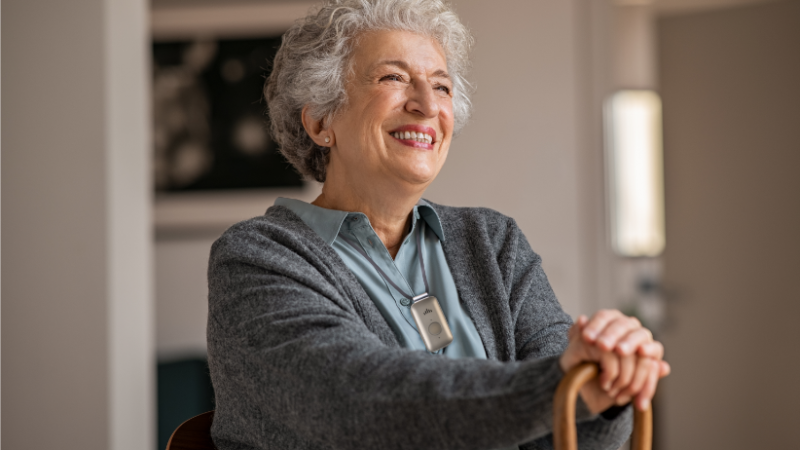Every second of every day, an adult in the U.S. over the age of 65 suffers from a fall, according to reports from the CDC. The report adds that 36 million falls occur every year among aging adults and one in every five falls causes an injury, such as a fracture.
If you or a loved one is 60 or older and are at risk of falling due to factors like impaired vision, osteoporosis, poor balance or taking medications that cause dizziness, a medical alert device with fall detection technology may be an ideal solution. This technology can automatically detect a fall when it’s happening and notify emergency medical services right away.
What Is Fall Detection Technology?
Fall detection is a technology that’s built into wearable devices like medical alert watches and necklaces that can tell whether you’ve fallen. It uses sensors called accelerometers that can measure speed and acceleration. Our devices use a triaxial accelerometer that measures vibrations in three areas of the body: at your waist, head to toe and posterior upward.
If the device senses an abrupt change in movement, it will activate the fall detection technology and automatically send a signal to an emergency operator at a monitoring center. When the operator receives the alert, they will contact you through the device to ask if you need help. If you don’t answer, the operator will send emergency services to you.
Benefits of Automatic Fall Detection Technology
Fall detection technology offers a wide range of benefits for aging adults—especially those who have a greater risk of falling. For instance, a recent study shows that these devices could have up to an average accuracy rate of 93% if the device is worn correctly. This technology is particularly useful if you lose consciousness after falling. Be aware that no fall detection technology catches 100% of falls so you should always push your help button if you need help.
Other benefits of automatic fall detection technology include:
- Speeds up help and lower the potential for complications from a fall.
- The technology is built into water-resistant devices, so it can be used in the shower.
- Can be added-on to your current medical alert system (only with Medical Guardian). This eliminates having to carry an extra fall-detection device.
- Produces an average response time of between one and 15 seconds, which is far lower than the industry average of 30 seconds.
- With mobile devices you carry fall detection with you no matter where you are in the US.
- For at-home devices, you have a range of up to 1,400 feet with, for example with the Classic Guardian.
Drawbacks to Fall Detection Technology
Like all other forms of technology, fall detection isn’t perfect and may not work as expected 100% of the time. For instance, research shows that fall detection necklaces are usually more accurate than fall detection bracelets. A medical alert with fall detection works most accurately when the device sits at the breast plate of the wearer.
A “false fall” signal can be sent accidentally. For example, if your medical alert device drops to the ground, it could send an alert to the monitoring center and an operator may call to see if you need help. If this happens, simply let the operator know that the device fell, and you do not need help. Or you can cancel the call before the operator response. Each device has a way to cancel a call, if needed. Be sure to test your device if it hits the ground.
How to Properly Wear and Use Alerts with Fall Detection
Medical alerts with built-in fall detection are commonly available as necklaces and bracelets.
If wearing a necklace, adjust the lanyard so it sits high on your chest, as this could make it work more accurately. Always wear it close to your body so it can easily detect falls. When putting the necklace on, avoid swinging the device to prevent it from interpreting any rapid movements as a fall.
A fall detection bracelet can be worn around either of your wrists like a watch. A device has the best chance of detecting a fall when it’s worn properly around your neck, but a fall detection device can be worn around your wrist. Be aware that certain arm motions—such as waving your arms, swinging a tennis racket or riding a horse—may sometimes send false alerts to the monitoring center.
Carefully read and follow all the instructions that come with your medical alert device to learn how to properly wear and use fall detection technology. Every medical alert device comes with its own specific set of instructions based on its type and unique features.
At Medical Guardian, we understand how important it is for aging adults to have access to medical help when they need it. All of our medical alert systems come with the fall detection add-on feature so you can stay safe in your home and/or on the go. Contact us today at (800) 668-9200 to learn more about our medical alert systems and fall detection add-on.

